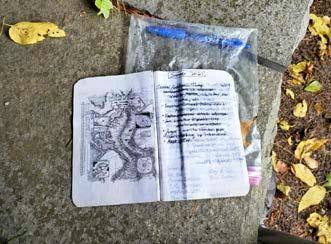


















 By Staff Reports
By Staff Reports
The U.S. Department of Transportation’s Federal Transit Administration and U.S. Sen. Majority Leader Chuck Schumer’s office notified TCAT General Manager Scot Vanderpool that his agency was awarded an $8.74 million grant through the FTA’s Low or No Emission (LowNo) Grant Program. The money will be used to purchase 10 more batteryelectric transit vehicles, to include six 40-foot and four smaller buses.
In April 2021, TCAT launched seven of its first-ever electric-battery buses, manufactured by Proterra, after securing money from the Low-No program. TCAT’s goal is to transform its entire fleet of what is now comprised of more than 50 buses to become entirely emissions free by 2035.
“Our riders and community members have been so appreciative to see
emission-free mass transit vehicles on the street; tangible evidence that we are making strides toward a cleaner-andgreener future,” Vanderpool said. “Our community has always been forwardthinking in pushing for environmental sustainability, which in turn has inspired TCAT to aggressively pursue funding over the past several years to make that vision a reality.”
According to an FTA news release issued on Tuesday, that reality from a national standpoint translates to hundreds of cleaner vehicles on the country’s thoroughfares. “With today’s awards, we’re helping communities across America – in cities, suburbs, and rural areas alike – purchase more than 1,800 new buses, and most of them are zero-emission,” said U.S. Transportation Secretary Pete Buttigieg, in the news release. “Funded through President Biden’s Bipartisan Infrastructure Law, this announcement means more
good jobs for people across the country, cleaner air in our communities, and more affordable and reliable options to help people get to where they need to go.”
Earlier this year, TCAT started the lengthy procurement process to purchase what was initially proposed to be five more full-sized Proterra buses to arrive on site by late spring of 2023. TCAT is still finalizing the funding mechanism to pay for those buses, which might include money from a combination of state-administered capital funding programs and existing capital money from TCAT’s own coffers. Due to financial constraints, however, that acquisition is not yet finalized and the number of buses from that order might be reduced to three or four, Vanderpool said.
“Naturally, this week’s FTA award announcement really took a great deal of financial pressure off of TCAT to fulfill much-needed capital improvements,” Vanderpool said, “And, we are so thankful to the Biden Administration, to New York’s U.S. lawmakers to include both Sen. Schumer and U.S. Sen. Kirsten Gillibrand, and our many other advocates for their tireless efforts at getting this massive clean-energy legislation through its many hurdles.”
Vanderpool said the next step is for TCAT staff to establish a timeline for yet another procurement process, noting that it takes several months to manufacture any type of transit bus. He said the current plan is to use the award to fund six 40-foot Proterra Model ZX5 electric buses; four smaller Lightning E Motor electric micro buses; overhead chargers to be installed at TCAT’s facility; and money to train TCAT mechanics on emission-free technology.
Register today for the YMCA’s Santa Run 5k and Family Elf Mile fun run ! Join Santa and friends at Stewart Park at 9 a.m. on Saturday, December 3. Hot cocoa, cookies, and music will set the stage for the annual non-competitive race and free family fun run.
Registration for the Santa Run 5k is $25 per adult participant, $20 for youth, and $45 for families (just added!). The Family Elf Mile is free, but we ask that you sign up in advance for planning purposes.
Proceeds of the event support the Y’s Membership Assistance Program scholarship fund, making health,
recreation, childcare, and community programs available to all.
Sign up at IthacaYMCA.com to celebrate the arrival of the holiday season. Santa Run is presented by the YMCA of Ithaca and Tompkins County with support from Cayuga Health System, Advantage Sport and Fitness, and Cayuga Radio Group.
ON
COVER: Ph.D candidate Spencer Beswick and his lost notebook ignited a spoon-full of mystery on the campus of Cornell University.
Visit our website at www.ithaca. com for more news, arts, sports and photos. Call us at 607-277-7000
o C hberger , a SS o C iat E p u B li S h E r , x 1214 larry @ thaca t im E s com
F r EE lan CE r S : Barbara Adams, Stephen Burke, G. M Burns, Alyssa Denger, Jane Dieckmann, Charley Githler, Ross Haarstad, Steve Lawrence, Marjorie Olds, Henry Stark, Bryan VanCampen, and Arthur Whitman
THE ENTIRE CONTENTS OF THE ITHACA TIMES ARE COPYRIGHT © 2022, BY NEWSKI INC.
All rights reserved. Events are listed free of charge in TimesTable. All copy must be received by Friday at noon. The Ithaca Times is available free of charge from various locations around Ithaca. Additional copies may be purchased from the Ithaca Times offices for $1. SUBSCRIPTIONS: $89 one year. Include check or money order and mail to the Ithaca Times, PO Box 27, Ithaca, NY 14851. ADVERTISING: Deadlines are Monday 5 p.m. for display, Tuesday at noon for classified. Advertisers should check their ad on publication. The Ithaca Times will not be liable for failure to publish an ad, for typographical error, or errors in publication except to the extent of the cost of the space in which the actual error appeared in the first insertion. The publisher reserves the right to refuse advertising for any reason and to alter advertising copy or graphics deemed unacceptable for publication. The Ithaca Times is published weekly Wednesday mornings. Offices are located at 109 N. Cayuga Street, Ithaca, NY 14850 607-277-7000, FAX 607-277-1012, MAILING ADDRESS is PO Box 27, Ithaca, NY 14851. The Ithaca Times was preceded by the Ithaca New Times (1972–1978) and The Good Times Gazette (1973–1978), combined in 1978. FoundEr good t
gazEttE: toM newton
 By Matt Dougherty
By Matt Dougherty
New York State passed the marijuana regulation and taxation Act (MRTA) in March of 2021, officially legalizing adult use of cannabis while laying the groundwork for the office of cannabis management (OCM) to issue various types of licenses for legal adult use cannabis businesses. On November 21, 2022 the state finally began issuing its first licenses for businesses to start legal recreational cannabis sales.
A press release from the Office of Cannabis Management said they began the process of issuing licenses by “approving 28 licenses for business owners with a cannabis conviction or family members with a cannabis conviction.”
The licenses are part of the Conditional Adult-Use Retail Dispensary (CAURD) program, which is a central pillar of the New York State Seeding Opportunity Initiative.
Through the Initiative, New York’s first legal adult-use retail dispensaries will be operated by those most impacted by the enforcement of the prohibition of cannabis or nonprofit organizations whose services include support for the formerly incarcerated.
Over the last 30 years, Black New Yorkers were 15 times more likely to be arrested for cannabis than white New Yorkers. For Latinos, it was eight times more likely. Accordingly, the majority of the license awardees announced today are people of color.
The Office of Cannabis Management received over 900 applications for CAURD licenses. At least one CAURD license was granted in each available region of the state. The awarding of these CAURD licenses represent the completion of New York’s initial cannabis market supply chain as designed by the Seeding Opportunity Initiative, introduced by Governor Kathy Hochul in March 2022.
As part of the Seeding Opportunity Initiative, individuals who are awarded CAURD licenses will receive support from the Social Equity Cannabis Invest-
ment Fund. Up to 175 licenses will be granted in total: as many as 150 to individual applicants and up to 25 to nonprofit applicants.
Ithaca’s Deputy Director of Economic Development, Thomas Knipe has said, “the goal of CUARD dispensaries is really to provide a leg up to equity businesses and locally owned businesses in the New York cannabis industry.”

During a recent Planning and Economic Development meeting Knipe said the city has “done a lot to connect with and support individuals in our community who are interested in participating in this industry and basically be an information source about what the different types of licenses are and how to apply.”
Common Council member Phoebe Brown responded to Knipe saying that she had concerns about the city’s outreach to minoritized communities because organizations that she’s involved with “never heard that this discussion was happening.”


Knipe continued saying that the state is currently evaluating a recreational dispensary site on the Ithaca Commons for a CUARD license and that “a final determination will be made about whether to move forward with the site within the next couple of weeks.”

According to Knipe, “If they decide to move forward the state will contract with a highly qualified design firm to build out the space into a retail dispensary location which would open early next year.”
Less than a week after Knipes comments the Office of Cannabis Management released a list of where the first 36 recreational cannabis dispensaries will be located.
According to the OCM the number of licenses awarded to each region in NYS is:
• Long Island - Seven
• Queens - Six
• Capital Region - Four
• Manhattan - Four
• New York City - Four
• Bronx - Three
• Southern Tier - Two
• Staten Island - Two
• Binghamton - One
• North Country - One
• Mohawk Valley - One
• Ithaca - One
• Rochester - One
• Syracuse - One
Eight of these licenses have been awarded to non-profit organizations which can now open their stores whenever they are ready. For the remaining 28 businesses, they will have to wait for New York State to lease and build out the dispensary and then the state will award the dispensary to the licensees.
It remains unknown how long that process will take, but according to New York State law, dispensaries can start delivering when they’re ready — which means that recreational cannabis delivery could start in New York before dispensaries even open.
Tremaine Wright, Chair of the Cannabis Control Board said, “This is just the start, we will continue to work to build an industry that is open to anyone who wants to participate. Many thanks to Governor Kathy Hochul and her unwavering support as we all work to make sure New York has the most equitable and inclusive cannabis industry in the nation.”

IF YOU COULD BE ANY ANIMAL OR PLANT FOR 24 HRS, WHAT WOULD YOU BE?
“My dog Phillip, he has no responsibilities.”
Leon M.
Cheetah.”
Bri S.
Danica W. “Moss, because it is so adaptable.”
Kaela, K.
“An owl because they are stealthy.”
Josh, J.A recreational use cannabis dispensary. (Staff Photo)
The City of Ithaca has had plans to construct a pedestrian bridge across the flood control channel near Wegmans for several years, and they are finally moving forward with the project. Local officials say the bridge could be installed by the end of summer 2023.
The project has proposed to construct a new multi-use trail over the Flood Control Channel to connect nonvehicular traffic between the intersection of Cecil Malone Drive and Cherry Street on the east of the channel to the Floral Avenue Trail on the west side of the channel.

According to Tim Logue, the Director of Engineering for the City of Ithaca, “The project will begin at that intersection, and we will build a path from that side to down to the flood control channel, and then the bridge goes across the water to connect with the Floral Avenue trail on the far side.”

The need for this project is to improve infrastructure with the construction of a new Black Diamond Trail multi-use trail bridge over the Flood Control Channel. The new bridge will link the existing multi-use trail and provide a walking and biking connection over the Flood Control Channel, connecting the City’s West Hill area to the Southwest commercial area and the Cherry Street industrial Park, both significant job centers in Ithaca.
The project provides a key component of the Black Diamond Trail, as
planned by New York State Office of Parks Recreation & Historic Preservation, and the only non-motorized crossing of the Flood Control Channel, saving a 0.75 mile walk around.
The Black Diamond Trail master plan calls for this bridge to carry the trail over the flood control channel, and then from that point the proposed trail would turn south and run down to buttermilk falls.
The project’s objective is to provide a safe travel alternative for pedestrians and bicyclists through a new multiuse trail bridge crossing of the Flood Control Channel meeting the latest design standards, improving handicap accessibility, encouraging alternative modes of transportation and promoting pedestrian and bicycle activity.
According to Logue, “we just opened bids on the bridge the other day, and we’re short on our budget so we have to go to the common council to try to fill the gap.”
Logue also said that 80 percent of the costs were being provided by federal grants and the City of Ithaca will
only have to cover 20 percent. However, he explained that federal aid is capped at 80 percent, so if costs go up over what was written in the grant the city will have to cover the payment.
Logue continued saying, “I can tell you that four years later, a pandemic and cost of construction all over the place means that even just the superstructure of the bridge itself is nowhere near what we estimated it to cost when we wrote the grant that summer.”
According to Logue, the existing authorization for the project is $1.5 million but he is asking the Common Council to increase funding for the bridge to $2.4 million. Logue says that the superstructure of the bridge itself that goes over the water will be built off site and then brought to the location to install it. “I would imagine most of the work would begin in April or May…and I would expect the bridge to be installed by late summer.”
The nationally ranked No. 9/10 Ithaca College football team will play in its first NCAA quarterfinal since 2003 after the Bombers defeated Springfield College, 31-20, in the second round of the Division III Championship at Butterfield Stadium on November 26.
Based on the results from last week’s Ithaca Times community poll it appears that a whopping 77.4% of voters had “no idea what the goals of the Ithaca Green New Deal are.”

In response to the recent mass shooting at the Club Q nightclub in Colorado Springs students at Cornell University are organizing a candlelight vigil on Dec.1st to honor and remember the victims of the tragic event.
Gas prices are falling once again in New York after increasing in the weeks leading up to Thanksgiving.
IF YOU CARE TO RESPOND to something in this column, or suggest your own praise or blame, write news@ithacatimes.com, with a subject head “U&D.”
Growing up in the Apple Belt in Wayne County, New York, Alex Skutt recalls driving weekends with his mother and older sister between Ithaca and their home in North Rose. Summers they lived in their cottage nearby on Leroy Island in Sodus Bay. “When my father was alive, he was an enthusiastic fisherman. We would explore in our wooden motorboat the Bay and in nearby Lake Ontario.” When Alex was six his father suddenly died, and the family decided they would live in Ithaca, New York during the week to be near his older sister studying at Cornell. Weekends they would return to Wayne County, where his mother provided the bookkeeping for the family’s apple farm.
In Ithaca Alex attended Henry St. Johns Elementary School, Boynton Middle School, and Ithaca High. While
he enjoyed math and science, he also savored English and history studies. After completing a degree in Engineering Physics at Cornell University, Alex turned down an aerospace engineering fellowship. Upon graduation he joined the Movement for a New Congress in 1970, headquartered locally in Sheldon Court in Collegetown, where he became Upstate co-chairperson for several years. Much of its printing work was provided by Glad Day Press, located on Stewart Avenue, a radical printing company, organized by the I.W.W. (Industrial Workers of the World).
After the social and political upheaval of the 60’s, Americans were introduced to punk rock with its hard edge, and disco with its pulsat-
Igot a jump on Christmas this year, and sunk the whole budget in FTX, with the thought of bestowing the cryptocurrency of the future on friends and family. It was a rare mis-step. My instincts for Christmas presents are usually spot on. There’s plenty of time to start over, though for ‘tis the holiday spending season, the jolliest quarter of the year, when corporate boardroom floors across the land are merrily trimmed with new-fallen drifts of well-chewed fingernails.
According to a recent study commissioned by Cornstarch, Inc., the non-military part of our economy is consumer spending, most of which occurs between Thanksgiving and New Years. It’s no stretch to suggest that it’s our patriotic duty, especially this year, to buy stuff that was made in other countries from each other on our official product-themed national holidays: Black Friday, Cyber Monday and Small Business Saturday. We need more, though, and there are plenty of unclaimed days. As usual, Ithaca can lead the way…
Distilled Beverage Friday (December 2): Myer Farm Distillery just up the road on Route 89. What better way to ring in the season than a field trip? Probably just a coincidence that a 375mL bottle fits perfectly in a stocking.
Microbrewery Monday (December 5): Two days ought to be enough to recover from Distilled Beverage Friday. I’ll be bouncing between Revelry Yards and Lucky Hare, being downtown and all, doing my economic duty. Not sure if this will add to the gift pile, but it sure sounds like fun.
White Wine Wednesday (December 7): After a well-deserved rest day, it’s time to hit the trail. To Northside. I say why drive all over the Finger Lakes, when the legwork’s already been done? They have shopping carts, gift bags, and Christmas music.
Lest anyone think that rushing headlong into alcoholism is our only path to salvation, there’s Adopt-a-Pet

Thursday (December 8). The Tompkins County SPCA is a no-kill shelter and there are plenty of wonderful holiday gifts to be had. A kitten, for example, makes an excellent stockingstuffer, and I guarantee you every child on your list would love a surprise puppy. Way better than dumb old cryptocurrency, and I think this is the way I’m going this year.
Storm Prep Saturday (December 10): Santa’s workshop is floating on a giant raft anchored to the floor of the Arctic Ocean, but only a true Grinch would fail to see the myriad new gift opportunities provided by wild and unpredictable weather patterns. Generators, batteries, flashlights, drums of fresh water, cartons of hardtack and pemmican…soon enough all that stuff will be as synonymous with the holidays as wreaths and candy canes.
Tech-stock Sunday (December 11): Could be there are bargains to be had, what with those kooky billionaires slashing jobs and whatnot. Of course, Meta and Twitter could also disintegrate like the Christmas Story lamp. It’s potentially the most exciting gift of the season.

Cryptomining Moratorium Monday (December 12): A Christmas present to all of us. Seneca Lake Guardian and Assembly Member Anna Kelles are definitely on the Nice List.
Yoga Tuesday (December 13): Gift cards! The half of the Ithaca’s population that are licensed instructors can charge the other half for an hour of poses and breathing. Everyone wins, and it’s an economic bonanza. I’ve gotten really good at shavasana, the dead body pose.
Hemp Day-Hump Day (December 14): Any product that is created naturally and which is biodegradable, like a hemp-based product, screams “buy me for a holiday gift.” Kids, especially, just love knobby, scratchy, grayish, prewrinkled garments.
That will get us to the next column, if we haven’t maxed out our cards by then. Keep spending, and happy holidays!

An update from the twilight zone that is currently the Town of Caroline…
It’s been a wild week as national press arrived in our tiny town and town leadership has not taken kindly to that – canceling a long-scheduled board meeting at the eleventh hour and largely avoiding opportunities to meet with experts whose message they did not want to hear.
On the bright side, much of the community enjoyed a lively and enlightening conversation with national author and planning scholar Nolan Gray about the nature of zoning and its impacts on communities across America, coming away with a greater understanding of the larger picture.
Indeed, there’s no getting around the fact that zoning has an embarrassing and inherent legacy of discrimination and NIMBYism that has played out along race and class lines since its inception in subtle and not so subtle ways.
Yet it’s fascinating that the Town seems content to sweep the historical, cultural and institutional aspects of zoning under the rug and look only to the environmental ones (for which the case is paper-thin). Zoning has contributed much to our dependency on cars and fossil fuels by arbitrarily blocking mixed uses. And it’s redlined communities in so many ways that are not easy to undo.
An argument often touted is simply that “zoning is everywhere so it should be here” – ignoring the fact that zoning is presently undergoing a national reckoning with a push to reform and repeal quickly gaining momentum in many states. Just as Caroline moves in the opposite direction, looking backward to a past we want to grow meaningfully away from.

It’s also been stated that zoning’s problematic track record somehow doesn’t apply to rural communities, a manufactured distinction that makes little sense if you follow it through. The issues are the same as zoning fractures communities along class and equity lines and their intersections. That’s already happened here in Caroline when a store that serves primarily those living in poverty was actively blocked
with a years-long moratorium so that us “elites” would not have to look at an ugly yellow sign in our backyards.
The “comprehensive plan” for the town of Caroline states:
People of all identities — including, but not limited to race, gender, sexual orientation, age, religion, disability, national origin, or veteran status — are safe, welcome and valued. The supportive and neighborly ethos of a small rural community is extended to all residents, as the Town recognizes the value that diversity of all identities brings. The Town is actively engaged in antiracist initiatives and policy to guide Town decisions.
A noble statement.
But if inclusion is so important to our community, this leaves us with one question. Why are so many of the people who should be concerned about the obscene underpinnings of zoning willing to look away?
Of course, it’s become increasingly clear that none of this even matters because a complex web of federal and state grants to the county have been the quiet force actually driving zoning in Caroline. It’s possible to trace all this strife back to mandates from FEMA that require municipalities to implement flood laws and hazard mitigation plans in order to be eligible for disaster aid. These forces seem to have informed the overlays in Caroline’s zoning draft as well as the county hazard plan’s stated goal to fix the “problem” of Caroline being unzoned for the last 200 years.
Isn’t it high time to end this changeinitiative gone wrong?
Zoning is scary; it shouldn’t be sugar-coated. It’s an American tragedy, responsible for the arbitrary lines that rule our lives. And like a cigarette habit, the best way to kick it is not to start.
So let’s make a motion to stop this nightmare and restore happiness and healing to our little town.
As the Ithaca College football team took the home field for Saturday’s Division III playoff game, there were very few students in attendance, as most of them were still on Thanksgiving break. That did not feel normal.
The home crowd was about half as boisterous as the visiting crowd. Abnormal.
To complete the Abnormal Trifecta, in Ithaca’s first possession, A.J. Wingfield – the Bombers’ unflappable field general that had led the team to an 11-0 season coming into the game –scrambled, panicked, and threw a very ill-advised and uncharacteristically bad pass that was intercepted and turned into six points, less than 2 minutes into the game. That was some Twilight Zone-level abnormality.
The Bombers’ next possession would feature more frustration, as a three-and-out put the Pride’s offense back on the field, Springfield’s vaunted triple-option attack was on display, and when their QB faked a pitch, saw a hole and went 40-some yards downfield, the Bomber faithful decided to wake up a little and became a bit more vocal. A stout defensive stand prevented the visitors from going up by two touchdowns, but field goal would put the hosts in a 10-zip hole.
On the next possession, Wingfield came alive. The senior signal caller orchestrated a methodical and effective drive, firing an absolute laser (to Billy Tedeschi) to the sideline on a 4th and 6 to keep the drive alive, unleashing another dart (this one to Jon Crowley) to get the Bombers to the 5 yard line, and a 3-yard run (by Jake Williams) put Ithaca on the board.
The momentum would start to turn thanks to the bruising play of the Bomber defense, and the Pride would hurt its own chances by committing four turnovers on the day. The teams would enter the locker rooms at halftime with the Bombers up 21-20.
The second half was all Ithaca. The Pride would generate a promising drive, and the Bomber defense would force a turnover. That pattern took some of the wind out of the visitors’ sails, and Ithaca would put ten more points on the board in the second half to seal the 31-20 win and a 12-0 record.
In the win, Wingfield passed for 168 yards (on 20-of-28 attempts), picked up 88 yards on 15 carries, AND grabbed one reception for 23 yards. Jalen Leonard-Osbourne had three touchdowns on four receptions for 101 yards, and also ran for 20 yards on eight attempts. Workhorse Williams pounded out 52 yards on the ground.
Ithaca will face North Central, the 2019 national champions, next Saturday in Naperville IL to earn a trip to the national semifinals. This is the first time since 2003 the team has advanced this far.

Cornell History Ph.D. candidate Spencer Beswick this past October received a shocking Twitter direct message from a Cornell librarian who shared a Twitter thread with him and asked if he was “Spoon.”
“My first thought was ‘Oh shit, what did I do because only my housemates know me as Spoon, am I in trouble?’” Beswick said.
Instead, the thread revealed a search to find the owner of a mysterious notebook circulating around Cornell’s campus for over a year, in and out of the hands of strangers.
As he read through the thread, Beswick realized that the person they were looking for was him — and it stirred his emotions.
“Reading through it, I teared up right away,” Beswick said. “I was kind of having a bad day at the time, and to just feel this sense of connection with a bunch of strangers online, who, you know, we’re all interested in this mystery, and could all take a little break from our bad days.”
A small decomposition notebook that Beswick lost around August 2021 organically became a Cornell diary. And when people stumbled upon the notebook, they wrote a message in it and then left it for others to find.

The found notebook first connected dozens, and ultimately hundreds, of strangers.
Software developer Krzysztof Hochlewicz and his girlfriend Cheryl
Qian were near the A.D. White House on the Cornell campus when they noticed a plastic bag containing a notebook and a pen.
“SPOON” was written on the waterlogged notebook. There was no contact information. The book contained notes
but then the pages transformed into diary entries clearly made by different people.
“A couple of the entries are pretty depressing with people writing how they are tired of life and are using the notebook as a means to express their frustration,” Hochlewicz said.
“But I think even in that sense it still served a really valuable purpose,” he added, “because it was an outlet for something that maybe someone felt they couldn’t tell their friends, so I think it’s a really interesting glimpse into the daily lives and minds from just
30 random people who found this on campus.”
That evening, with the help of some paper towels and a hairdryer on maximum heat, Hochlewicz spent three hours drying out the fragile notebook page by page.
Hochlewicz and Qian combed through the notebook in search of unique and identifying life details that could help them find Spoon. After searching Google, Qian found someone she thought might be Spoon –Marshall Project reporter Keri Blakinger.
When Blakinger, received an email with the subject line “Are you ‘Spoon’? Found something in Ithaca that might be yours,” she wanted to help.
She isn’t Spoon, but Blakinger was intrigued. She wrote a book, “Corrections in Ink,” which made her a candidate for the notebook’s owner. She spent time in Ithaca working on the memoir.
She tweeted to her followers and the response was immediate. Within an hour of posting, Beswick was found.
Former Ithaca Mayor Svante Myrick even retweeted the thread.
The Twitter thread had multiple comments from people trying to solve the mystery, and some simply said that the thread made their day or that they wanted to start a Spoon notebook on their campus.
What transpired moved Beswick.
“To just have something that could purely be good and joyful,” he said, “I felt connected with all these people on Twitter.”
For those few days, Hochlewicz was invested in the mystery and what to do with the notebook.
“Before I knew who Spoon was, I already thought that this was something really cool,” Hochlewicz said.


“A lot of the entries are really inspiring, or people saying like they had an awful day and finding this notebook and seeing what everyone else wrote in it brought a smile to their face,” he added.
Hochlewicz said he was heartened that this little notebook was making its collective authors consider disconnecting from technology — or posting it to Instagram — until they read through it and decided to simply to leave their own entries.
“I didn’t want to break that tradition,” Hochlewicz said.
He decided to digitize it, share it on Reddit and then write his own entry and send the book out to circulate on campus once more.
Beswick loved this idea and reassured Hochlewicz when they met in person that he did the right thing.
“There’s a worry that the magic will be lost, but I think that we need examples of magic,” Beswick said. “We need this kind of window into a new world, a window into new possibilities that
can inspire people, even if that is simply leaving a journal on a campus.”
A little notebook containing Beswick’s personal thoughts transformed into a community of thoughts. A support system for strangers.
Beswick said if he could lose the notebook again, he would. The difficulties people are having due to politics and the pandemic have distanced people from one another, and he feels this notebook has been an antidote to that.
“Something like this becomes a way to connect in the real world with real people. ”
The digitized Spoon notebook can be found on Reddit and contains a downloadable pdf of the current entries.
If you ever find yourself on Cornell’s campus, you might just stumble upon a decomposition notebook and pen in a Ziploc bag.

“It’s the community possession now,” Beswick said. “I don’t own this; other people don’t own it. It’s something that is a collective creation.”
“Yeah, there’s something beautiful to that,” he added.
This story was written by Lucy Calderon, a senior journalism student at Ithaca College.













reason you are a bassist� That’s definitely not a conventional path�
KR: Nothing about it has been a conventional path for me. I’ve done this the most f****ed up and strange way that anyone’s ever done. I had no expectations that I would ever be a professional musician in any regard. I was just obsessed with music and kept playing and kept getting gigs, but I never expected it to go where it’s gone. Lo and behold, the universe has a way.
IT: What’s the driving source of inspiration with your music?
KR: I want to make fun, exciting, bombastic music that you don’t have to be on 12 tabs of acid to enjoy. I like psychedelic music. I like heavy music. I like dance music. And I feel like my tunes sort of encompass all of that. I just want my shows to be places where people come together, dance, let go of all inhibitions and just have a moment of serenity through bass bombs and sort of exploration. I need that space for myself too.
IT: Your most recent song “Arbitrary” came out in 2021, I hear you also have a debut record in the works, any updates on that front?
By Ryan BieberBass guitarist and songwriter Karina Rykman is playing at the Upstairs on Nov. 30th. Rykman is most well known as the bassist for Marco Benevento but has enjoyed a successful solo career as well. Her first single “Plants” has garnered more than 1 million streams on Spotify.

As Rykman prepares to release an album in 2023, she is touring the Northeast with Ithaca as her first stop. In preparation for her show, she sat down with the Ithaca Times to discuss her upcoming tour and album as well as her songwriting process and her unconventional journey to becoming a bass guitarist.
*This interview has been edited for length and clarity.
Ithaca Times: So you grew up in Manhattan� I read in a recent interview that you stayed with a friend in the Hudson Valley during the pandemic� Have you ever been to Ithaca before?
Karina Rykman: I have! I’ve only ever been there playing in Marco Benevento’s band, which is a gig I’ve done for the last six years. We’ve had many great shows at the Haunt and also at the Rongo, both places that I know no longer exist. But this will be my first time coming through with
my band and I cannot wait to soak it all in. I’m excited to see the new place.
IT: You’ve filled in as a bassist for a lot of bands whether it be Marco Benevento or more recently with Seth Meyers 8G band� How do you approach a gig where you’re subbing in versus when you’re the frontwoman?
KR: When it’s somebody else’s music and you have to go step in, your mindset goes to ‘How do I best serve this song?’ With my band, it is really rather refreshing to be able to call all the shots and steer the ship myself, which means that if I want to run around the stage, like a complete lunatic animal like I do, I will do that. It’s really a mindset shift where you can just be like, Oh, I can do whatever I want. This is my show, baby. Let’s go.’ It’s.
IT I know you originally started by playing guitar, but what inspired you to pick up the bass?
KR: I started first on guitar when I was 12 and throughout high school I basically played both guitar and bass in whatever bands or projects called for. It wasn’t until the Marco Benevento gig that I basically decided. “Yo, this is no joke, Karina, you’re a bass player.”
IT: That’s fascinating to me that Marco Benevento calling you up and asking you play bass in his band is the main
KR:You can definitely expect to hear a lot of unreleased stuff at the show in Ithaca, and all throughout the tour as well. As for the record, it’s done. And I can’t say too much more about it, but it will be out next year. All I can say is to get this out into the universe after waiting for so long is going to be the most cathartic, incredible moment in my life.
IT: You’re a top-tier bassist regardless of gender, but in general, bass guitar is a very male-dominated sphere� Is that ever difficult for you, or do you find the community to be pretty open and welcoming?
KR: I’ve had my fair share of bullshit, but I love to prove motherf****ers wrong, When I encounter any sort of wackness … I’ve been known to confront people in a coy way. But for the most part, I would definitely say everyone that I’ve encountered, for the most part has been super welcoming, respectful and cool, as they should be.”
Many women come up to me at shows and tell me that being myself, so unequivocally, has emboldened them to be themselves, unequivocally. And that’s worth everything to me. I didn’t set out to be that guy, but if I am, that’s incredible. I just hope everybody feels understood and emboldened to be themselves in this lifetime.
*Rykman will be playing the Upstairs on 106 S. Cayuga St, 8:00-11:30 pm on Wednesday Nov. 30.
 By Arthur Whitman
By Arthur Whitman
The artist, suggests visionary modernist painter Paul Klee, is like a tree. Speaking in a 1924 lecture in Jena, Germany—later published as “On Modern Art”—he unpacks his simile. Comparing the artist to a trunk, her crown the efflorescence of her art, he speaks as well of roots: “the sense of direction” that brings “order into the passing stream of image and experience.”
A concern for trees—as both metaphors and literal things—animates the current exhibition at SUNY Cortland’s Dowd Gallery. “Family Tree,” which closes after this Friday (December 2), brings together work by four geographically dispersed Slavick sisters: elin O’Hara, Madeleine, Sarah, and Susanne.


This is an expanded version of an earlier presentation: “Family Tree Whakapapa,” held during 2020 and 2021 at venues in Masterton and Auckland, New Zealand. “Whakapapa” is a Maori term suggesting a confluence of genealogy and cosmology—an appropriate image for this iteration as well.
There’s an undeniable aura of high purpose to these siblings’ art. The work is political in spirit, though rarely didactic, aiming for a poetic appreciation of trees—and by extension the whole more-than-human world—persisting in the face of manmade challenges such as deforestation and global warming.
elin O’Hara Slavick, of Irvine, California, presents gelatin silver photo-
graphs and cyanotypes (“blueprints”) offering reflection on the atomic bombings of Hiroshima and Nagasaki as well as the 2011 nuclear disaster at Fukushima, Japan. A major focus is on images of the hibakukjumoku, “survivor trees” of Hiroshima. A series of solarized and otherwise manipulated images of persimmon trees irradiated in the more recent crisis are emblematic of the show’s twin themes of beauty and danger.
Her work, elegant and beguiling, partakes of what one might call a poetics of haunting. The shimmering lightscapes and blurred silhouettes of her alternative process photographs are fitting metaphors for human and environmental loss.
Madeleine Slavick, of Wairarapa, New Zealand, is an author of poetry and literary non-fiction as well as an accomplished, if more conventional photographer. In “Lattice I – XIII,” hung Salon-style, and in other smaller groupings, her digital prints offer humorous and provocative views of trees forced into often banal or incongruous human-made settings.
In her oil on canvas paintings and works on paper, Sarah Slavick of Boston creates a kind of poetic biology, giving vibrant painterly life to unseen worlds of cells and subterranean branching structures. A generous sampling from her recent “Elegy to the Underground” series, offers homage to the intelligence and sociality many scientists now ascribe to




Playing like a mash-up of a George A. Romero zombie epic, and Orson Welles’ 1938 radio play of H.G. Wells’ “War of the Worlds”, House of Ithaqua’s new adaptation of Tony Burgess’ 2007 film “Pontypool” is a pre-recorded performance presented as a slab of a news radio station’s broadcast as a zombie attack takes hold. (The voices and radio sounds are goosed by an onscreen oscilloscope that pulses gently during the story’s quiet sections and wilder kinetic when events turn chaotic and insane.) The show’s director, Jeff Hodges, achieves real fear and tension from the sounds of confused silence.
The Ithaca Times spoke to HOI’s Artistic Director, A.J. Sage, about finding “Pontypool”, recording it, and how people can rent it until December 3rd.

AJS: Tony Burgess first wrote “Pontypool” as a novel called “Pontypool Changes Everything”, and it was then a film, then a stage play, and finally, a radio play, which is the script that we’re going off of. And without spoiling too much, it’s a zombie play, but it’s got to do with language. We recorded vocal tracks, much like doing a live play with our voice cast. Our director, Jeff Hodges, edited those performances as you would a film, taking the good snippets from each performance, and then Norm Scott, our sound designer, built this really awesome soundscape around it that included both practical and digital sound effects.

IT: Where did you discover this piece?
AJS: Jeff was just a really big fan of the movie, and he likes to talk about how it’s the horror movie he shows to horror fans, because it’s something that a lot of people haven’t seen. And so a couple of years ago when he discovered that there was this radio version, he just
got really excited [laughs] about House of Ithaqua doing that. This was just something that Jeffery wanted to do.
IT: How long has this been in the works?
AJS: Gosh, I’d say the idea was born about nine months ago – seems appropriate [laughs]. Between the casting and the recording and the sound design, it all took about five months.
IT: I thought the oscilloscope was very effective, very powerful�
AJS: Yeah, I would say that we’ve been getting a really positive response, especially regarding just how much it sounds like a radio broadcast. Because it’s not just a radio play, it’s a radio play that, in the world of the play, is on the radio. I think the biggest challenge for the sound design has been how to delineate the characters when they’re on the air and when they’re talking to each other off the air.
IT: How can people get their hands on “Pontypool”?
AJS: The “Pontypool” stream lasts until December 3rd. The stream can be purchased through our website, houseofithaqua.com, and the stream is hosted on Vimeo on Demand. The run time is 61 minutes, and the renter has 48 hours to listen once they rent the stream.
Recommended: “She Said” at Cinemapolis and Regal Stadium 14.
root networks. Her ink and watercolor pieces on paper are her most compelling. Hung on a long wall, a grid of unframed “Elegy” sheets provides an anchor for this eclectic show. Though striking, they may provoke mixed reactions in those of us attuned to what has become a familiar strain in contemporary art: decorative, intricate, lyrical maps or cosmologies. Up close, most of these explode with rich colors and dazzling, dotted patterning. Back up a bit and the repeated motif of the root—here softer, there more angular— becomes something of a cartoon.
I had the most difficulty appreciating Susanne Slavick’s work here. It strikes me that an art seeking to illuminate the unity of things in nature might begin with a forceful artistic unity—in this case, a pictorial unity. The strategy of throwing together diverse source materials in a stylistically and formally arbitrary manner is endemic to recent
academic art. It’s rarely aesthetically compelling and it doesn’t work well here. And I don’t think it illuminates the intended subject matter.
Susanne, who is based in Pittsburgh, offers pieces from two series here. A row of seven tall, scroll-like “Tree of Life” photo-paintings juxtapose monochrome images of devastated forests—found online and taken from around the world—with hand-painted designs “appropriating” Middle Eastern rugs, their intricate decorative patterns representing cosmological world trees. One can appreciate the intended sentiment: that the holistic sense offered by traditional myth may provide a kind of reparation and solace from our modern ruin.
A final special event, a reading of some of these poems by SUNY Cortland faculty, will be held at the gallery on Thursday, December 1, beginning at 5pm.
“Family Tree” at SUNY Cortland’s Dowd Gallery 48 Graham Ave, Cortland Through December 2






Sunday, December 4th, 3:00 - 5:00 p.m.


First Unitarian Society of Ithaca 306 North Aurora St , Ithaca, NY 14850
All are welcome! Light refreshments will be served Stop by for a bit or stay for the entire gathering. Brief remembrance program begins at 4:00 p m Contact us at events@hospicare org or 607-272-0212 for more information or to RSVP
ing beat, pop art and a more diverse array of authors. In 1973 Alex founded McBooks, named in honor of Senator George McGovern. At that time, the sale of books was still robust, especially in college towns like Ithaca: Corner Book store, Smedley’s, Logos, The Bookery, Triangle Book Store and Borealis dotted our landscape.
Once Alex was confident McBooks was launched, he hired Knock on Wood to renovate the store at 106 N. Aurora Street. In its heyday McBooks had a second location - Quest’s End on the Commons, specializing in Science fiction, Mystery, and Games.
In 1982 Alex and partner Richie Berg opened Video Ithaca. Eventually that enterprise expanded with outlets on Rt. 13 (where ZaZa’s Restaurant once was located), in Master Craft Art and Frame shop on State and Corn Streets, in the P&C Collegetown Bagels in the East Hill Plaza and in Cayuga Mall located across from the Shops of Ithaca. “Our video stores were architecturally designed by Holt Architect Peter Forlano, to make the searching for videos a pleasant experience, with such features as multicolored neon
lights in the Children’s Section, a display of movie-sized candy for sale, a system by which customers could reserve movies in advance and my favorite feature--the big screen minitheater that seated 6 customers”.
Over the years even though American’s time devoted to leisure time activities greatly expanded, locally owned bookstores and video stores became less popular. Over time Alex sold his interest in his local ventures and devoted himself to authoring and publishing at McBooks Press. His own publications specialized in historical naval adventures. Alex also co-authored the 5 volume The Boxing Register. These books can be found online and, in some brick, and mortar bookstores.
In all McBooks Press published approximately 200 books. This was Alex’s last business enterprise, except for printing a community biography of his hometown of North Rose, NY.
This change in focus also has freed up more of Alex’s time to spend with family. Son, Ethan, a mechanical engineer, schooled at Northeastern University, currently lives in Ithaca, NY. Ethan shares many of the same interests Alex recalls from his own life when he was Ethan’s age.
